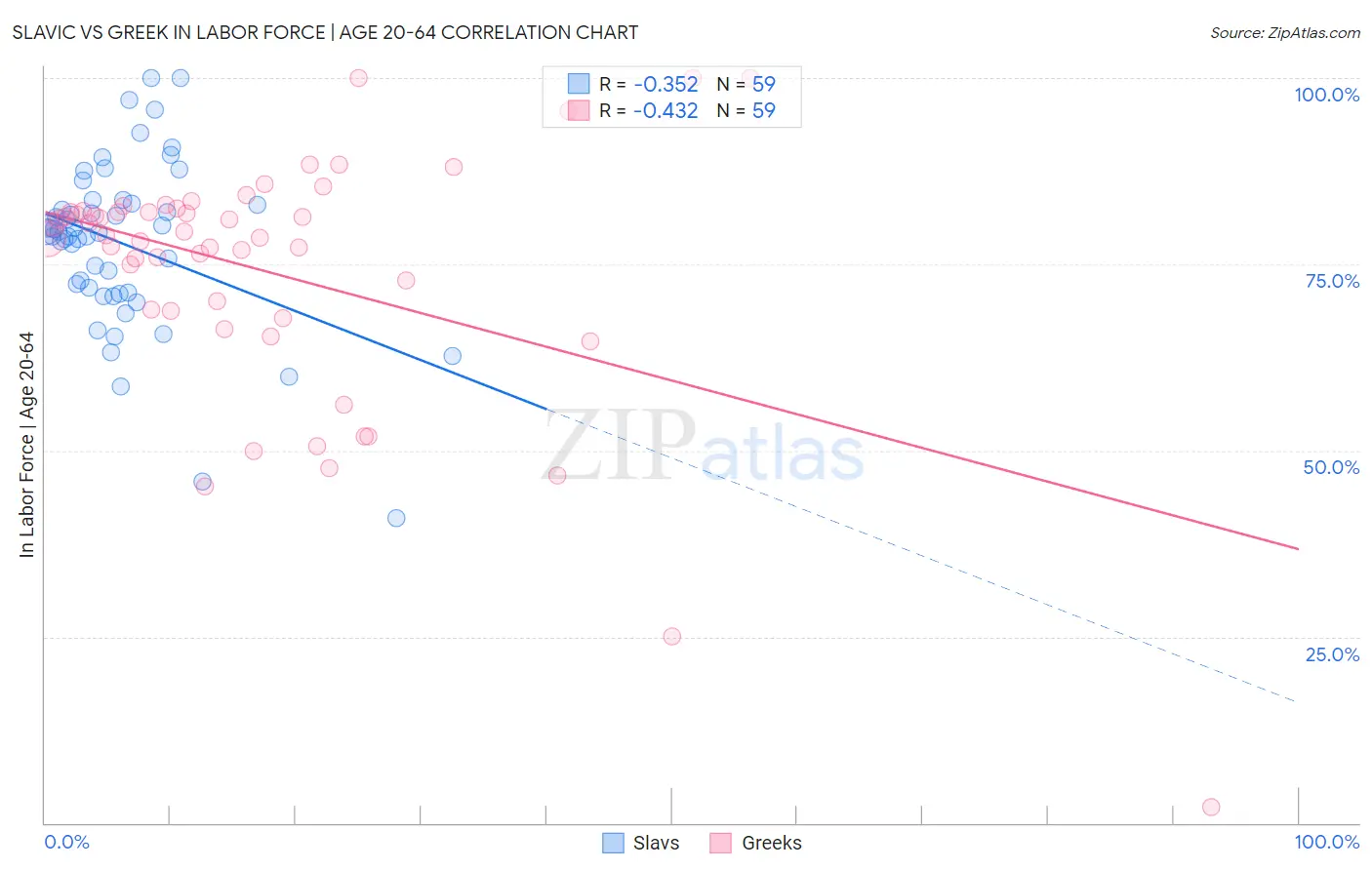Slavic vs Greek In Labor Force | Age 20-64
COMPARE
Slavic
Greek
In Labor Force | Age 20-64
In Labor Force | Age 20-64 Comparison
Slavs
Greeks
79.6%
IN LABOR FORCE | AGE 20-64
54.0/ 100
METRIC RATING
170th/ 347
METRIC RANK
80.0%
IN LABOR FORCE | AGE 20-64
94.8/ 100
METRIC RATING
106th/ 347
METRIC RANK
Slavic vs Greek In Labor Force | Age 20-64 Correlation Chart
The statistical analysis conducted on geographies consisting of 270,879,770 people shows a mild negative correlation between the proportion of Slavs and labor force participation rate among population between the ages 20 and 64 in the United States with a correlation coefficient (R) of -0.352 and weighted average of 79.6%. Similarly, the statistical analysis conducted on geographies consisting of 482,783,615 people shows a moderate negative correlation between the proportion of Greeks and labor force participation rate among population between the ages 20 and 64 in the United States with a correlation coefficient (R) of -0.432 and weighted average of 80.0%, a difference of 0.55%.

In Labor Force | Age 20-64 Correlation Summary
| Measurement | Slavic | Greek |
| Minimum | 40.9% | 2.2% |
| Maximum | 100.0% | 100.0% |
| Range | 59.1% | 97.8% |
| Mean | 77.8% | 74.0% |
| Median | 79.5% | 79.0% |
| Interquartile 25% (IQ1) | 71.2% | 68.7% |
| Interquartile 75% (IQ3) | 83.1% | 82.1% |
| Interquartile Range (IQR) | 11.9% | 13.4% |
| Standard Deviation (Sample) | 11.3% | 17.3% |
| Standard Deviation (Population) | 11.2% | 17.1% |
Similar Demographics by In Labor Force | Age 20-64
Demographics Similar to Slavs by In Labor Force | Age 20-64
In terms of in labor force | age 20-64, the demographic groups most similar to Slavs are Immigrants from Switzerland (79.6%, a difference of 0.010%), Immigrants from Belgium (79.6%, a difference of 0.010%), Immigrants from Scotland (79.6%, a difference of 0.010%), Syrian (79.6%, a difference of 0.030%), and Laotian (79.6%, a difference of 0.040%).
| Demographics | Rating | Rank | In Labor Force | Age 20-64 |
| Immigrants | Costa Rica | 64.6 /100 | #163 | Good 79.7% |
| Immigrants | Burma/Myanmar | 64.4 /100 | #164 | Good 79.7% |
| Nigerians | 64.0 /100 | #165 | Good 79.7% |
| Okinawans | 62.7 /100 | #166 | Good 79.6% |
| Immigrants | Iraq | 62.0 /100 | #167 | Good 79.6% |
| Immigrants | Indonesia | 61.8 /100 | #168 | Good 79.6% |
| Laotians | 58.4 /100 | #169 | Average 79.6% |
| Slavs | 54.0 /100 | #170 | Average 79.6% |
| Immigrants | Switzerland | 53.3 /100 | #171 | Average 79.6% |
| Immigrants | Belgium | 53.1 /100 | #172 | Average 79.6% |
| Immigrants | Scotland | 52.4 /100 | #173 | Average 79.6% |
| Syrians | 50.0 /100 | #174 | Average 79.6% |
| Cubans | 46.1 /100 | #175 | Average 79.5% |
| Australians | 46.0 /100 | #176 | Average 79.5% |
| Immigrants | Netherlands | 45.2 /100 | #177 | Average 79.5% |
Demographics Similar to Greeks by In Labor Force | Age 20-64
In terms of in labor force | age 20-64, the demographic groups most similar to Greeks are Immigrants from Jordan (80.0%, a difference of 0.0%), Immigrants from Ghana (80.0%, a difference of 0.010%), Venezuelan (80.0%, a difference of 0.020%), Iranian (80.0%, a difference of 0.020%), and Filipino (80.1%, a difference of 0.030%).
| Demographics | Rating | Rank | In Labor Force | Age 20-64 |
| Immigrants | Chile | 95.7 /100 | #99 | Exceptional 80.1% |
| Filipinos | 95.6 /100 | #100 | Exceptional 80.1% |
| Palestinians | 95.5 /100 | #101 | Exceptional 80.0% |
| Immigrants | Australia | 95.5 /100 | #102 | Exceptional 80.0% |
| Russians | 95.5 /100 | #103 | Exceptional 80.0% |
| Venezuelans | 95.3 /100 | #104 | Exceptional 80.0% |
| Immigrants | Ghana | 95.0 /100 | #105 | Exceptional 80.0% |
| Greeks | 94.8 /100 | #106 | Exceptional 80.0% |
| Immigrants | Jordan | 94.8 /100 | #107 | Exceptional 80.0% |
| Iranians | 94.3 /100 | #108 | Exceptional 80.0% |
| Immigrants | Argentina | 94.1 /100 | #109 | Exceptional 80.0% |
| Estonians | 94.0 /100 | #110 | Exceptional 80.0% |
| Immigrants | South America | 93.9 /100 | #111 | Exceptional 80.0% |
| Immigrants | Italy | 93.9 /100 | #112 | Exceptional 80.0% |
| Sri Lankans | 93.9 /100 | #113 | Exceptional 80.0% |